Gangapurna Expedition
The Gangapurna Expedition is a challenging and awe-inspiring mountaineering journey that takes place in the stunning Annapurna region of Nepal. Situated between Annapurna III and Tilicho Peak, Gangapurna stands tall at an impressive height of 7,455 meters (24,457 feet). This magnificent peak offers breathtaking views of surrounding giants such as Manaslu, Annapurna I, Annapurna II, Annapurna III, Annapurna IV, Tilicho Peak, Pisang Peak, Chulu West Peak, Chulu East Peak, and more. It is a paradise for experienced climbers seeking a thrilling and rewarding adventure.
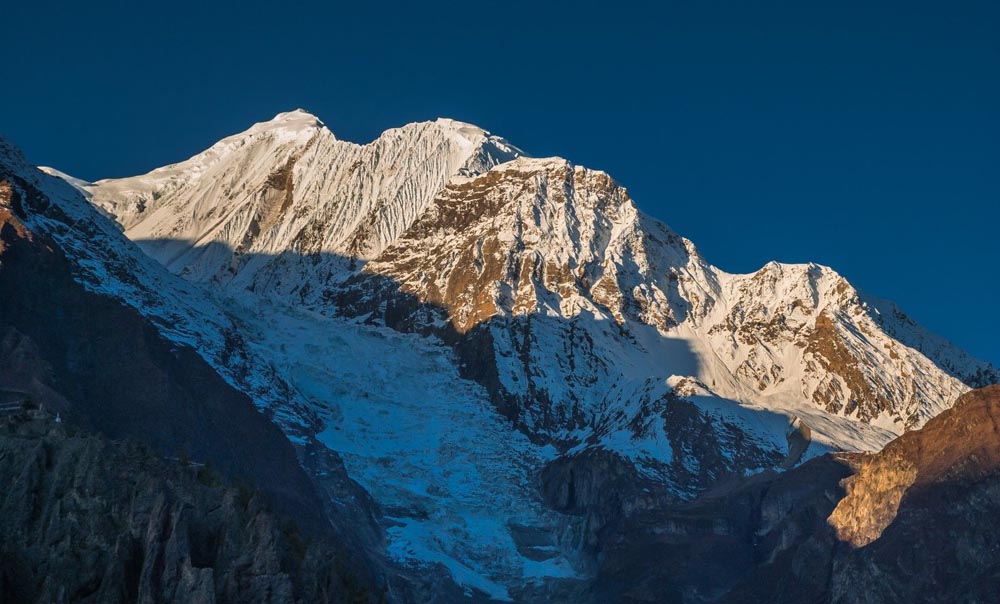
The expedition begins in Kathmandu, where climbers embark on a trek through the Marsyangdi Valley, passing traditional Tibetan Buddhist Manang villages adorned with monasteries, prayer flags, and Mani stones. The trail winds through diverse landscapes, including lush forests of pine, fir, and rhododendron, eventually leading to higher altitudes characterized by sparsely vegetated and rocky terrain. The trek serves as an opportunity for climbers to acclimatize and soak in the natural beauty of the Annapurna region.
Upon reaching Gangapurna Base Camp at an elevation of 4,650 meters (15,256 feet), the climbers begin their preparations for the summit. The expedition involves establishing three upper camps (Camp 1, Camp 2, and Camp 3) along the route, providing necessary resting points and support for the final ascent. Climbers must possess a high level of fitness, mountaineering skills, and familiarity with alpine climbing techniques. The climb includes navigating through snow and ice, overcoming technical sections, and utilizing equipment like crampons, ice axes, harnesses, and grappling ropes. With careful planning, acclimatization, and the guidance of experienced Sherpa guides, climbers make their way to the summit, where they are rewarded with unparalleled views of the surrounding Himalayan peaks.
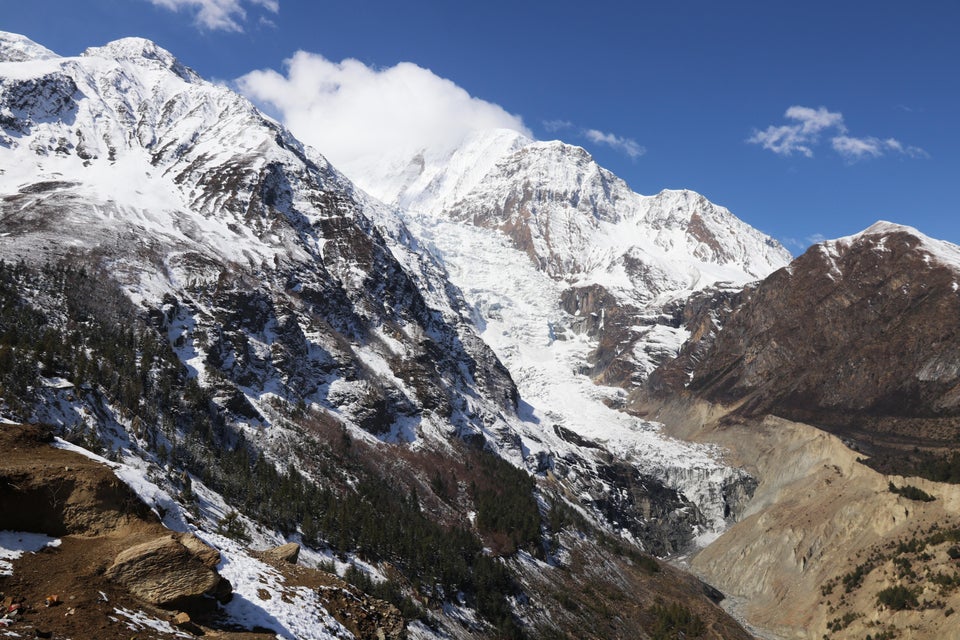
Gangapurna Expedition offers an unforgettable experience for experienced mountaineers. It combines the thrill of challenging climbs with the mesmerizing beauty of the Annapurna region, making it a dream destination for those seeking adventure, stunning landscapes, and a sense of accomplishment. Safety, proper acclimatization, and expert guidance are vital to ensure a successful and enjoyable expedition in this magnificent Himalayan range.
History of the Gangapurna Expedition
The Gangapurna Expedition has a rich history that began on April 6, 1965, when a German team led by Günther Hauser successfully made the first ascent of the mountain via the Southeast Ridge. Since then, Gangapurna has enticed climbers from around the world to test their skills on its challenging slopes. Over the years, various teams have attempted the peak using different routes, contributing to the exploration and understanding of the Annapurna region. Despite its allure, Gangapurna has also witnessed tragedies, with avalanches and treacherous conditions claiming lives. Nevertheless, the accessibility of the Annapurna region has improved with better infrastructure and facilities, making the expedition more feasible. Gangapurna has served as a training ground for mountaineers, offering valuable experience for tackling other Himalayan peaks. Today, the Gangapurna Expedition continues to attract adventurers seeking the thrill of conquering a formidable mountain amidst the awe-inspiring landscapes of Nepal's Annapurna region.
Highlights of the Gangapurna Expedition
The Gangapurna Expedition offers several highlights for climbers who undertake the challenging ascent. Here are some of the key highlights:
- Stunning Himalayan scenery with breathtaking views of the Annapurna massif and neighboring peaks.
- Technical mountaineering challenges involve steep snow and ice slopes, glacier crossings, and challenging weather conditions.
- Remote and pristine environment, offering a sense of solitude and tranquility amidst the Himalayan wilderness.
- Cultural immersion with opportunities to interact with local communities and experience the unique Gurung and Manang cultures.
- Gradual acclimatization process and training to adapt to the high-altitude environment and enhance mountaineering skills.
- Sense of achievement and fulfillment upon reaching the summit and taking in panoramic views.
- The physical and mental challenge tests endurance, strength, and resilience.
Routes for the Gangapurna Expedition
The Gangapurna Expedition offers several routes for climbers to reach the summit of this challenging peak. Here are the commonly used routes:
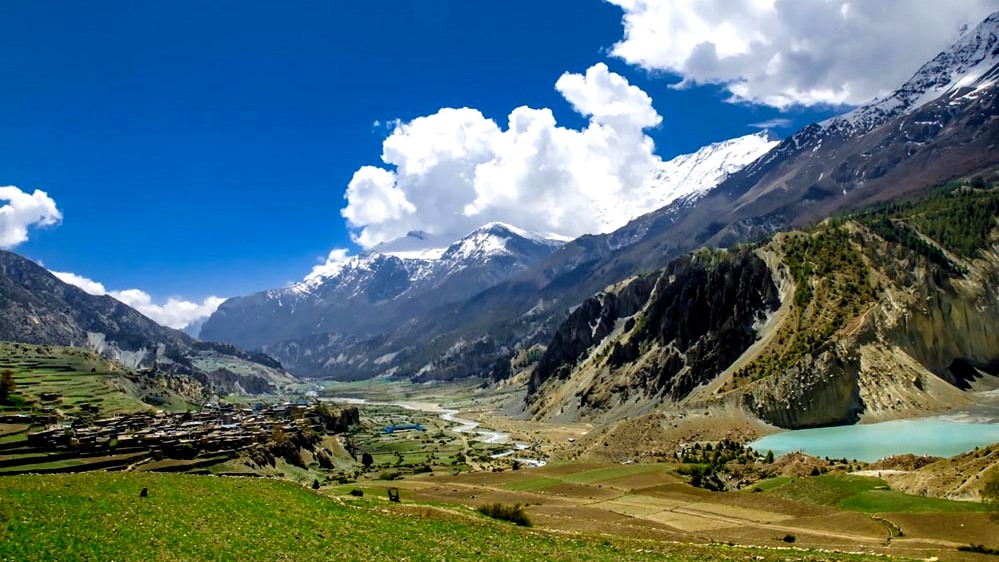
Southeast Ridge
Southeast Ridge is the most popular and commonly climbed route on Gangapurna. It was the route taken during the first ascent in 1965. Here are the main points of the route during the trek:
Starting Point: The expedition usually begins from the Gangapurna Base Camp, which is situated at an altitude of approximately 4,700 meters (15,420 feet). To reach the base camp, climbers typically trek through the Annapurna Circuit, passing through villages like Manang and Yak Kharka.
Base Camp to Camp 1: From the base camp, climbers ascend along a well-defined trail that leads to Camp 1. This section involves hiking on moraines and gradually gaining altitude. Camp 1 is usually located at around 5,500 meters (18,045 feet) and serves as a crucial acclimatization point.
Camp 1 to Camp 2: The route from Camp 1 to Camp 2 presents more technical challenges. Climbers encounter steep sections, rock bands, and sections of mixed terrain. Ropes and fixed anchors may be used to aid the ascent. Camp 2 is usually situated at an altitude of approximately 6,000 meters (19,685 feet).
Camp 2 to Summit: From Camp 2, climbers continue their ascent toward the summit of Gangapurna. This section involves navigating through icy slopes, and snowfields, and potentially traversing crevassed areas. The terrain becomes steeper and requires careful route selection and the use of appropriate climbing techniques. The final push to the summit may involve negotiating narrow ridges and cornices.
Summit: The summit of Gangapurna stands at an elevation of 7,455 meters (24,457 feet). From the summit, climbers are rewarded with breathtaking panoramic views of the surrounding Himalayan peaks, including Annapurna II, Annapurna III, and Tilicho Peak.
The Southeast Ridge route on Gangapurna demands a combination of rock climbing and ice climbing skills. Climbers should be proficient in using crampons, ice axes, and other technical equipment. It is essential to be adequately acclimatized and have prior experience in high-altitude mountaineering before attempting this route.
Northeast Ridge
The Northeast Ridge presents a challenging and captivating route for climbers aiming to conquer Gangapurna. This route starts from the northeast side of the mountain, offering a unique perspective on the ascent. As climbers venture along the Northeast Ridge, they encounter traverses on steep slopes adorned with snow and ice. The technical nature of this route demands proficient mountaineering skills and experience in navigating icy terrain. Despite its difficulties, the Northeast Ridge rewards climbers with breathtaking views of the surrounding Himalayan landscape. Additionally, this route provides a more secluded experience, allowing adventurers to immerse themselves in the tranquility of the mountains and forge a deep connection with nature. The Northeast Ridge of Gangapurna stands as a testament to the allure and challenge that mountaineers seek when undertaking expeditions in the grandeur of the Himalayas.

Northwest Face
The Northwest Face of Gangapurna offers a formidable and technically challenging route for climbers seeking a demanding ascent. This route requires advanced mountaineering skills and experience, as it involves navigating steep ice and mixed terrain. The Northwest Face is known for its vertical ice walls, intricate ice formations, and exposure to objective dangers such as avalanches and falling ice. Due to its high level of difficulty, this route is less frequently attempted compared to the more popular routes on Gangapurna. Climbers who choose to tackle the Northwest Face must be well-prepared, equipped with specialized gear for ice climbing, and possess the necessary skills and judgment to assess and mitigate risks associated with the route. Undertaking the Northwest Face route on Gangapurna requires a high level of technical proficiency, mental fortitude, and a thorough understanding of the mountain and its conditions.
Southwest Ridge
The Southwest Ridge of Gangapurna presents an intriguing and less frequented route for climbers seeking a unique perspective on the mountain. As one of the lesser-known paths, this route offers a sense of exploration and adventure. Ascending from the southwest side, climbers face technical challenges that demand proficiency in various climbing techniques. The terrain consists of steep sections, icy slopes, and rugged rock formations, requiring climbers to exhibit their skill and experience. While the Southwest Ridge may be less popular, it rewards those who undertake it with breathtaking views and a sense of solitude. The allure of this route lies in the opportunity to carve one's path and experience the mountaineering journey from a different angle.
It's important to note that the choice of route for the Gangapurna Expedition depends on various factors, including climbers' skills and experience, weather and snow conditions, and logistical considerations.
Mountain views seen during the Gangapurna Expedition
During the Gangapurna Expedition, climbers are treated to breathtaking mountain views in the Annapurna region of Nepal. Here are some of the notable peaks and scenic vistas that can be witnessed during the expedition:
Gangapurna: As the main objective of the expedition, climbers get an up-close and personal view of the magnificent Gangapurna Peak itself. The towering snow-covered summit and the surrounding ridges and glaciers showcase the grandeur of this challenging peak.
Annapurna Range: The Gangapurna Expedition offers stunning views of the Annapurna Range, which is one of the most prominent mountain ranges in the world. Peaks such as Annapurna I (8,091 meters), Annapurna II (7,937 meters), Annapurna III (7,555 meters), and Annapurna IV (7,525 meters) dominate the skyline with their majestic presence.

Tilicho Peak: As climbers trek and ascend in the Annapurna region, they may catch sight of Tilicho Peak (7,134 meters). This spectacular peak stands tall above the serene turquoise waters of Lake Tilicho, creating a picture-perfect scene.
Nilgiri Peaks: The Nilgiri Peaks, including Nilgiri North (7,061 meters) and Nilgiri Central (6,940 meters), offer a striking contrast to the surrounding landscape. These peaks, with their unique rock formations, stand out prominently and provide a stunning backdrop during the expedition.
Dhaulagiri Range: While not directly visible from Gangapurna, climbers may have glimpses of the mighty Dhaulagiri Range in the distance. Dhaulagiri I (8,167 meters), the seventh-highest mountain in the world, and its neighboring peaks present an awe-inspiring sight as they rise above the valleys and rugged terrain.
Panoramic Views: Throughout the Gangapurna Expedition, climbers are rewarded with breathtaking panoramic views of the surrounding Himalayan peaks, lush valleys, and deep gorges. These expansive vistas offer a sense of awe and wonder, allowing climbers to immerse themselves in the natural beauty of the Annapurna region.
It's important to note that the weather and visibility conditions can vary, impacting the clarity and extent of the mountain views during the expedition. However, the Annapurna region is renowned for its stunning landscapes and offers a rich tapestry of mountain scenery that captivates climbers throughout their journey.
How Difficult Is The Gangapurna Expedition?
The Gangapurna Expedition is considered a technically and physically challenging endeavor. It requires a high level of mountaineering skills, experience in high-altitude climbing, and the ability to navigate complex and varied terrain. Here are some key factors that contribute to the difficulty of the Gangapurna Expedition:
High Altitude
The Gangapurna Expedition involves climbing to high altitudes, with Gangapurna itself standing at 7,455 meters (24,457 feet). The high altitude presents several challenges for climbers. The reduced oxygen levels at such heights can lead to altitude sickness, affecting climbers' physical performance and overall well-being. Adequate acclimatization is crucial to allow the body to adjust to the thin air and mitigate the risks associated with high altitude. Climbers need to carefully manage their ascent, allowing sufficient time for rest and acclimatization at intermediate camps to minimize the effects of altitude. Proper hydration, nutrition, and monitoring of symptoms are essential to ensure climbers' safety and increase their chances of a successful summit.
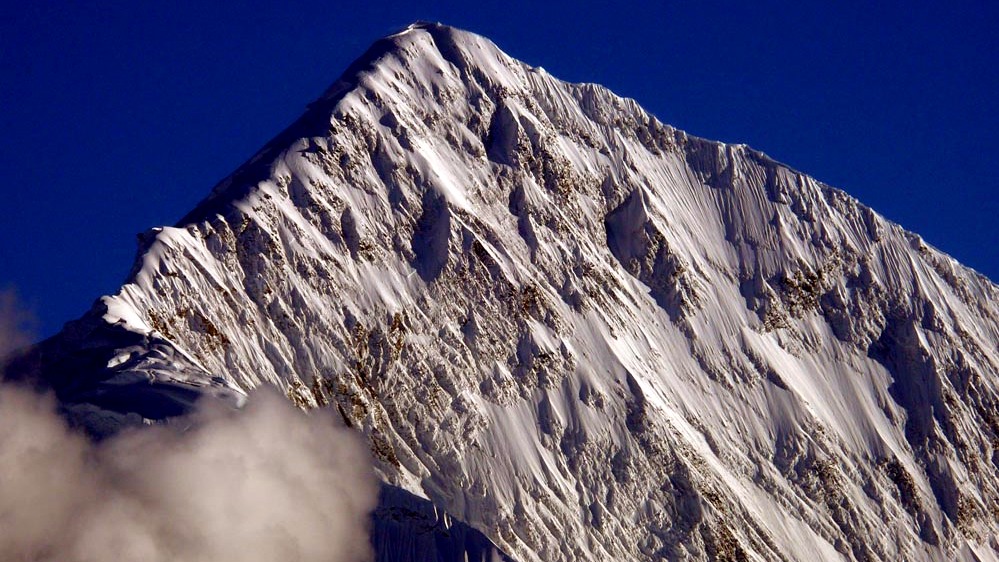
Technical Difficulty
The Gangapurna Expedition is known for its technical difficulty, requiring climbers to possess advanced mountaineering skills. The route includes steep snow slopes, ice sections, and potential rockfall hazards, necessitating expertise in using specialized equipment such as crampons, ice axes, ropes, harnesses, and helmets. Climbers must be proficient in techniques like ice climbing and crevasse rescue to safely navigate the challenging terrain. The technical difficulty of the expedition demands experience, knowledge, and the ability to make sound decisions in complex and demanding situations. Proper training and preparation are essential to ensure climbers can handle the technical challenges encountered on the ascent to Gangapurna's summit.
Length and Logistics
The Expedition requires careful planning and logistics due to its length and remote location. The expedition typically spans around 3 to 4 weeks, including trekking to the base camp, acclimatization periods, and the actual climb. Setting up camps at higher altitudes, managing supplies, and coordinating with support teams are crucial logistical considerations. The expedition requires proper equipment, including tents, food, and climbing gear, to sustain climbers throughout the journey. Additionally, arranging permits, transportation, and communication systems are important logistical aspects. Meticulous planning, organization, and coordination are necessary to ensure a smooth and successful Gangapurna Expedition.
Weather Conditions
Weather conditions during the Gangapurna Expedition can be highly unpredictable and challenging. The Himalayan region is known for its volatile weather patterns and harsh mountain climates. Climbers may encounter strong winds, snowstorms, rapid changes in temperature, and low visibility. It is essential for climbers to be prepared for adverse weather conditions and have the necessary equipment, such as warm clothing, waterproof layers, and sturdy gear, to withstand these challenges. Monitoring weather forecasts, being flexible with climbing schedules, and making informed decisions based on current weather conditions are crucial for the safety and success of the expedition. Climbers must prioritize their well-being and exercise caution in the face of challenging weather scenarios.
How to prepare for the Gangapurna Expedition
To prepare for the Gangapurna Expedition, it is crucial to focus on physical fitness and endurance. Engage in a well-rounded training regimen that includes cardiovascular exercises, strength training, and hiking or climbing practice. Build your stamina and endurance gradually over time to acclimatize your body to the demands of high-altitude climbing. Additionally, consider undertaking practice climbs on other peaks to gain experience and enhance your mountaineering skills. Mental preparation is equally important, as climbing at high altitudes can be physically and mentally challenging. Develop a positive mindset, mental resilience, and the ability to handle unpredictable situations. Familiarize yourself with the route, weather conditions, and potential risks associated with climbing Gangapurna. Make logistical arrangements, such as obtaining the necessary climbing permits, travel insurance, and necessary gear and equipment. Connect with experienced climbers, join training programs or expeditions, and seek guidance from professionals or climbing experts to ensure you are well-prepared for the expedition.
Permits for the Gangapurna Expedition
To undertake the Gangapurna Expedition, climbers need to obtain certain permits and permissions. Here are the main permits required for the expedition:
Annapurna Conservation Area Permit (ACAP): The Annapurna Conservation Area Permit is a mandatory permit for entering the Annapurna Conservation Area. Gangapurna is located within this protected area. The permit can be obtained in Kathmandu or Pokhara, and it is necessary for all climbers and trekkers entering the region. The permit fees contribute to the conservation and maintenance of the area.
Trekking Information Management System (TIMS) Card: The TIMS card is required for all trekkers and climbers in Nepal. It is intended to ensure the safety and security of travelers. The card can be obtained from the Nepal Tourism Board in Kathmandu or the TIMS counter in Pokhara. It requires providing basic information about the expedition, such as the duration, itinerary, and contact details.
Climbing Permit: In addition to the ACAP and TIMS card, climbers attempting the Gangapurna Expedition must obtain a climbing permit. The permit is issued by the Nepal Mountaineering Association (NMA) or the Ministry of Culture, Tourism, and Civil Aviation. The permit fee varies depending on the season, duration, and number of climbers on the team. It is essential to have a climbing permit as it grants access to the mountain and ensures compliance with regulations.
It is important to note that permit requirements and fees are subject to change, so it is advisable to consult with a reputable trekking agency or the appropriate authorities for the most up-to-date information. Additionally, climbers should carry their permits and necessary identification documents during the expedition as they may be checked at various checkpoints along the trekking route.
Best Season For Gangapurna Expedition
Since the climate and weather during the Gangapurna Expedition are quite unpredictable from season to season, the following information is provided for each season:
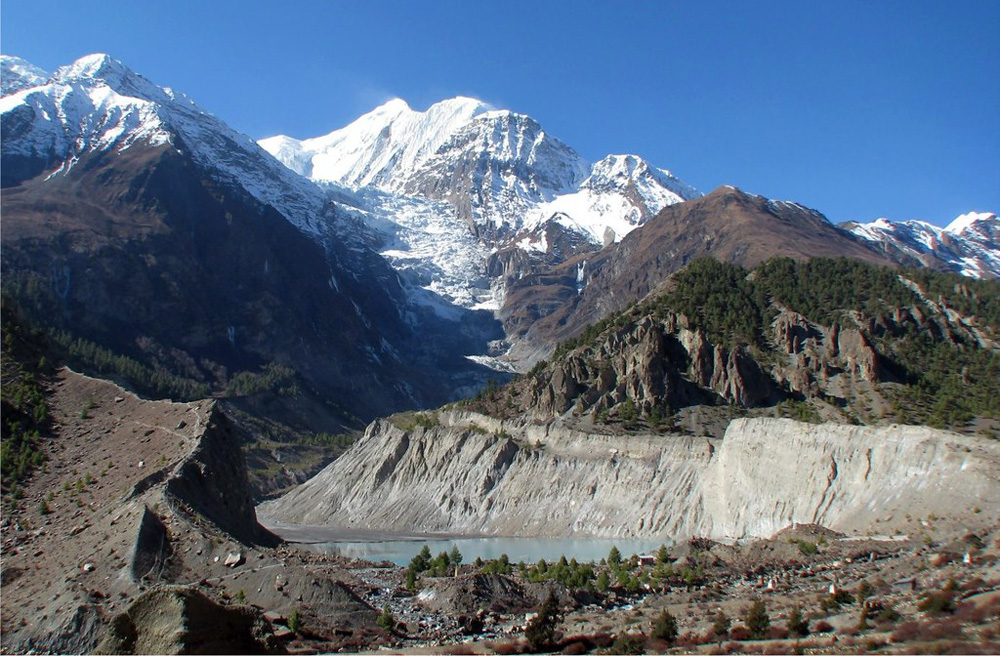
Spring Season (March to May)
The spring season is considered the best time for the Gangapurna Expedition. The weather during this period is generally stable, with clear skies and mild temperatures. The snow from winter starts to melt, making climbing conditions more favorable. The visibility is excellent, allowing climbers to enjoy panoramic views of the surrounding mountains and landscapes. However, it is important to note that the spring season attracts a higher number of climbers, so popular routes may be crowded.
Base Camp: The temperatures at the base camp during spring can range from around 0°C (32°F) to 10°C (50°F) during the day. However, temperatures can drop significantly below freezing during the night.
High Camps: As climbers ascend to the higher camps, the temperatures become colder. At the higher camps, temperatures can range from -5°C (23°F) to -15°C (5°F) during the day, and they can drop even lower at night.
Summer/Monsoon Season (June to August)
The summer or monsoon season is not recommended for the Gangapurna Expedition due to heavy rainfall, increased risk of landslides, and the possibility of avalanches. The weather is generally unstable, with frequent rain showers and cloudy conditions. The trails can become slippery and hazardous, making them challenging and unsafe for climbing.
Base Camp: During the monsoon season, temperatures at the base camp can range from 5°C (41°F) to 15°C (59°F) during the day. However, the humidity is high, and rainfall is frequent, making it feel colder and damp.
High Camps: In the higher camps, temperatures during the monsoon season can range from 0°C (32°F) to -10°C (14°F) during the day, with further drops during the night. Rainfall is more common at higher altitudes, and snowfall may occur.
Autumn Season (September to November)
The autumn season is another excellent period for the Gangapurna Expedition. The weather is stable, with clear skies, moderate temperatures, and minimal rainfall. The post-monsoon period brings fresh snow to the mountains, enhancing the scenic beauty of the region. The autumn season is less crowded compared to spring, allowing climbers to enjoy a relatively quieter experience.
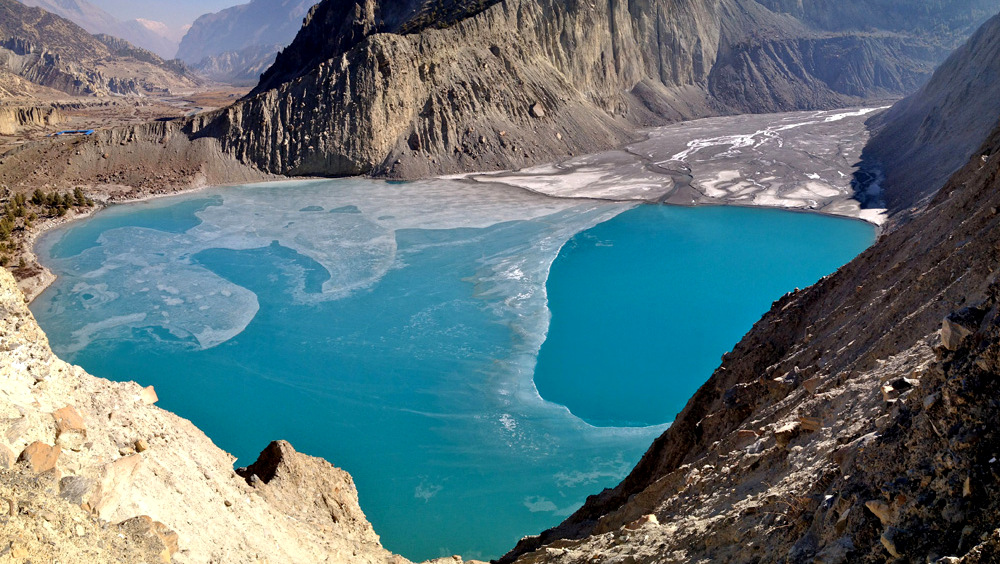
Base Camp: In autumn, temperatures at the base camp range from around 0°C (32°F) to 10°C (50°F) during the day, with colder temperatures during the night. The weather is generally clear and dry.
High Camps: Temperatures in the higher camps during autumn can vary from -5°C (23°F) to -15°C (5°F) during the day, and they can drop even lower at night. The weather is generally stable, with lesser precipitation compared to other seasons.
Winter Season (December to February)
The winter season poses significant challenges for the Gangapurna Expedition. The temperatures drop significantly, and the mountain receives heavy snowfall. The extreme cold, coupled with strong winds, makes climbing conditions extremely harsh and dangerous. The routes can be treacherous, and the risk of avalanches is high. Therefore, winter is generally not recommended for climbing Gangapurna.
Base Camp: During winter, temperatures at the base camp can range from -5°C (23°F) to 5°C (41°F) during the day, with significantly colder temperatures during the night. Winter brings heavy snowfall and strong winds to the region.
High Camps: In the higher camps, temperatures during winter can range from -10°C (14°F) to -25°C (-13°F) during the day, with even colder temperatures at night. The extreme cold, coupled with strong winds and heavy snowfall, makes climbing conditions extremely challenging and dangerous.
While spring and autumn are considered the best seasons, it's essential to keep in mind that weather patterns can be unpredictable in mountainous regions. It is recommended to closely monitor weather forecasts and consult with experienced guides or local authorities before planning the expedition.
Accommodation and Meals During The Gangapurna Expedition
During the Gangapurna Expedition, climbers typically stay in a combination of teahouses, base camps, and high camps. Here is an overview of the accommodation and meals available during the expedition:
Accommodations
Teahouses
Along the trekking routes leading to Gangapurna, there are tea houses or guest houses available in villages and settlements. These teahouses provide basic accommodation in the form of shared rooms or dormitories with beds, blankets, and pillows. The facilities are usually simple, with communal bathrooms and limited access to hot water. It is advisable to bring a sleeping bag for additional warmth and comfort.
Base Camp
The Gangapurna Base Camp is where climbers set up their main camp for acclimatization and preparation. At the base camp, climbers typically stay in tents that they bring along with them. These tents serve as a comfortable shelter during the expedition and offer privacy. Climbers need to carry their own sleeping bags, mattresses, and other personal equipment.
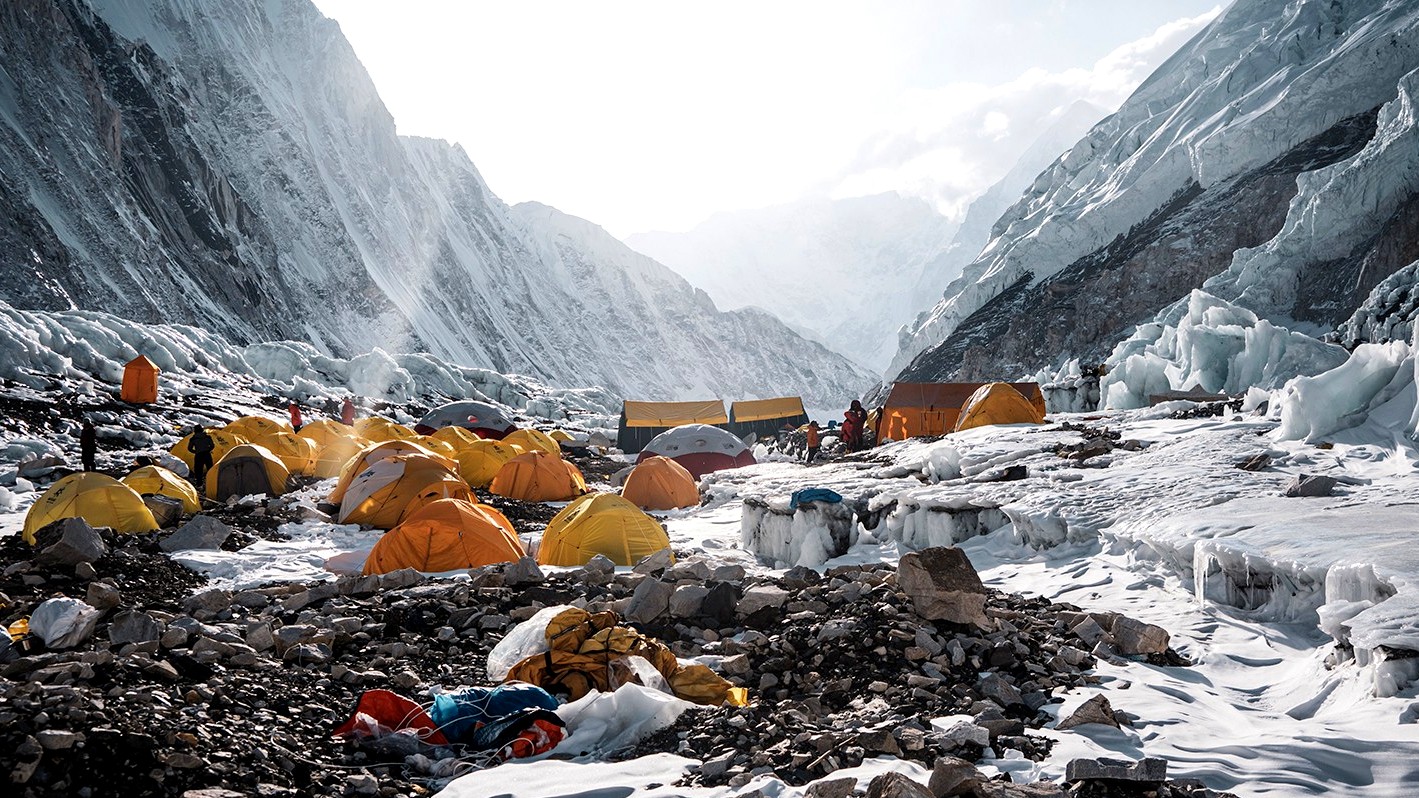
High Camps
As climbers ascend higher toward the summit of Gangapurna, they establish high camps at strategic points along the route. High camps are typically smaller, temporary camps where climbers rest and acclimatize before pushing for the summit. Similar to the base camp, climbers stay in tents at the high camps and are responsible for their own sleeping arrangements and equipment.
Meals
Meals during the Gangapurna Expedition are primarily provided at teahouses, base camps, and high camps. In teahouses, climbers can enjoy meals such as dal bhat (lentil soup with rice), noodles, pasta, momos (dumplings), and various local and international dishes. The availability and variety of food may decrease as climbers ascend to higher altitudes. At base camps and high camps, climbers usually have a designated cook or a team responsible for preparing meals using camping stoves and limited supplies. These meals typically consist of high-energy food, including soups, pasta, rice, lentils, potatoes, vegetables, and protein sources like eggs, meat, or canned fish. It is important to note that the availability of fresh ingredients may be limited at higher altitudes, and climbers may need to rely on pre-packaged or dehydrated meals.
It is advisable for climbers to carry some energy bars, and snacks, and drink plenty of fluids to maintain their energy levels during the expedition. It is also recommended to inform the trekking company or support team about any dietary restrictions or allergies beforehand to ensure suitable meal arrangements.
Travel Insurance for the Gangapurna Expedition
Having comprehensive travel insurance is highly recommended for the Gangapurna Expedition or any mountaineering expedition. Here are some important considerations regarding travel insurance for the expedition:
- Coverage: Ensure the policy covers mountaineering and high-altitude activities.
- High-Altitude Coverage: Check if the policy covers the altitude range of the expedition.
- Emergency Evacuation: Verify if the policy includes coverage for emergency helicopter rescue or medical evacuation.
- Medical Coverage: Confirm coverage for medical expenses at high altitudes.
- Trip Cancellation/Interruption: Consider coverage for trip cancellation or interruption due to unforeseen circumstances.
- Adventure Sports Coverage: Check if the policy covers adventure sports and activities related to mountaineering.
- Policy Exclusions and Limitations: Review exclusions, limitations, and claim filing procedures.
- Consult an Insurance Provider: Seek guidance from reputable insurance providers or brokers specializing in adventure travel.
Remember to thoroughly read and understand the terms and conditions of the insurance policy before purchasing it, ensuring that it meets your specific needs and provides adequate coverage for the risks associated with mountaineering in the Annapurna region.
Checklist for the Gangapurna Expedition
Here's a checklist of essential items for the Gangapurna Expedition:
Climbing Gear
- Mountaineering boots
- Crampons
- Ice axe
- Harness
- Helmet
- Climbing rope
- Carabiners and quickdraws
- Ascender and descender devices
- Mountaineering backpack
- Sleeping bag suitable for cold temperatures
- Sleeping pad or mattress
- Trekking poles
- Personal anchor system
Clothing
- Base layers (thermal tops and bottoms)
- Insulated mid-layers (fleece or down jacket)
- Waterproof and windproof shell jacket
- Waterproof and windproof shell pants
- Climbing pants or trekking pants
- Insulated gloves or mittens
- Waterproof gloves or mittens
- Warm hat or beanie
- Balaclava or face mask
- Sunglasses with UV protection
- Gaiters
- Socks (wool or synthetic)
- Mountaineering boots
Personal Equipment
- Backpack for day trips
- Headlamp with spare batteries
- Water bottle or hydration system
- Personal first aid kit
- Sunscreen (high SPF)
- Lip balm with SPF
- Personal toiletries and medications
- Pocket knife or multi-tool
- Whistle
- Map and compass or GPS device
- Trekking or climbing watch
- Camera and spare batteries
- Cash and necessary documents (passport, permits, insurance)
Technical Equipment
- Tent (if camping at base camp or high camps)
- Cooking stove and fuel
- Cookware and utensils
- Water purification systems or tablets
- Climbing helmet
- Climbing harness
- Climbing ropes and slings
- Carabiners and quickdraws
- Ice screws (if required)
- Snow pickets (if required)
- Avalanche safety gear (probe, shovel, transceiver)
Food and Nutrition
- High-energy snacks (nuts, energy bars, dried fruits)
- Electrolyte powder or tablets
- Lightweight and nutritious meals for base camp and high camps
- Thermos flask for hot drinks
Communication and Safety
- Mobile phone with a backup power bank
- Two-way radios (for team communication)
- Satellite phone (if necessary)
- Emergency beacon or locator device
- Personal locator beacon (PLB)
- First aid kit with essential medications and supplies
- Personal insurance documents and emergency contact numbers
Remember to customize the checklist based on your specific needs and preferences. It is important to consult with experienced climbers or trekking agencies for guidance and to ensure you have the appropriate gear and equipment for a safe and successful Gangapurna Expedition.
Tips for the Gangapurna Expedition
Here are some tips to help you prepare for the Gangapurna Expedition:
- Prioritize physical fitness through aerobic exercises, strength training, and hiking.
- Plan for gradual altitude acclimatization with rest days and gradual ascent.
- Learn and practice technical mountaineering skills like ice climbing and crevasse rescue.
- Invest in high-quality mountaineering gear and ensure proper gear testing and break-in.
- Prepare mentally for challenges and cultivate resilience and a positive mindset.
- Obtain necessary permits and comply with local regulations.
- Maintain hygiene and carry necessary hygiene products and water purification methods.
- Establish effective teamwork and communication with climbing partners.
- Respect the environment and adhere to Leave No Trace principles.
- Prioritize safety, stay informed about weather conditions, and adjust plans accordingly.
Remember to consult with experienced mountaineers, guides, or expedition companies for personalized advice and guidance specific to your situation.
FAQ (Frequently Asked Questions) for the Gangapurna Expedition in Nepal
Q: How high is Gangapurna?
A: Gangapurna is located in the Annapurna massif in Nepal and stands at an elevation of 7,455 meters (24,457 feet) above sea level.
Q: What is the best season for the Gangapurna Expedition?
A: The best seasons for the Gangapurna Expedition are spring (March to May) and autumn (September to November). These seasons offer stable weather conditions, clear skies, and favorable climbing conditions.
Q: How long does it take to climb Gangapurna?
A: The duration of the Gangapurna Expedition can vary depending on several factors, including the chosen route, climber's experience and acclimatization, weather conditions, and individual pacing. On average, the expedition can take around 3 to 4 weeks, including trekking to base camp, acclimatization, summit push, and descent.
Q: Do I need previous climbing experience to climb Gangapurna?
A: Yes, climbing Gangapurna requires previous climbing experience and technical skills. It is considered a challenging peak and requires proficiency in mountaineering techniques, including ice climbing, glacier travel, and high-altitude navigation. It is recommended to have prior experience in climbing peaks of similar difficulty before attempting Gangapurna.
Q: Do I need a permit for the Gangapurna Expedition?
A: Yes, you will need to obtain a climbing permit from the Nepal Mountaineering Association (NMA) to climb Gangapurna. The permit fee varies depending on the season and the number of climbers in the expedition.
Q: Is a guide or support staff required for the Gangapurna Expedition?
A: While it is not mandatory to have a guide for the Gangapurna Expedition, it is highly recommended, especially for climbers without prior experience in the region. A guide or support staff can provide valuable assistance in navigation, logistics, safety, and handling emergencies. They are familiar with the local terrain, and weather conditions, and can enhance the overall experience.
Q: What are the accommodation options during the Gangapurna Expedition?
A: During the expedition, climbers typically stay in seahouses/guest houses along the trekking route to the base camp. At the base camp and higher camps, climbers set up tents for accommodation. It is advisable to bring your own camping equipment, including a sleeping bag and mattress, for comfort and warmth.
Q: Is altitude sickness a concern during the Gangapurna Expedition?
A: Yes, altitude sickness is a potential concern during the Gangapurna Expedition. Proper acclimatization and a gradual ascent are essential to minimize the risk. It is crucial to be aware of the symptoms of altitude sickness and to follow the guidance of experienced climbers and guides.
Q: What kind of physical fitness is required for the Gangapurna Expedition?
A: Climbing Gangapurna requires a high level of physical fitness and endurance. It is recommended to engage in regular cardiovascular exercise, strength training, and hiking or climbing practice to prepare your body for the physical demands of the expedition. Consulting with a healthcare professional and a fitness trainer is advisable.
Q: Can I rent climbing gear in Nepal for the Gangapurna Expedition?
A: Yes, there are gear rental shops in Kathmandu and other major cities in Nepal where you can rent climbing equipment and gear for every expedition and climbing.
Similarly other 7000-meter peaks for Climbing and Expedition Packages in Nepal
Pumori Expedition (7,145 m)
Tilicho Peak Expedition (7,134 m)
Annapurna South Expedition (7,219 m)
8000-meter Mountain Expedition in Nepal
Makalu Expedition (8,463m)
Manaslu Expedition (8,163 m)
Kanchenjunga Expedition (8,586 m)
Lhotse Expedition (8,516 m)
Mt. Everest Expedition (8848.86 m)
Dhaulagiri Expedition (8,167 m)
6000-meter peaks for Climbing and Expedition in Nepal
Mt Ama Dablam Expedition (6,812 m)
Island Peak Expedition (6,160 m)
Mera Peak Climbing (6,476 m)
Chulu West Peak Climbing (6,419 m)
Pisang Peak Climbing (6,091 m)
Singu Chuli Peak Climbing (6,501 m)
If you need any further information, please contact us by email: at [email protected], Phone: at +977- 985 100 5129 (WhatsApp)
#Tags
Tripadvisor
5.0928 reviewsGoogle
4.8114 reviewsFacebook
4.1 recommend44 ReviewsTrustpilot
4.1 Great(5 reviews)- Trusted by50K plus traveller




